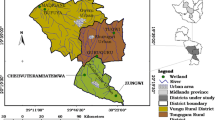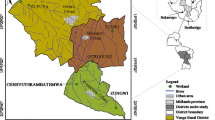Abstract
The issue of food security has received increasing emphasis in developing countries, particularly in the cities. The emphasis on food security has engendered agricultural expansion and encroachment on the coastal and inland wetlands in these nations. To facilitate and sustain the security of food in the developing countries local and international policies have been designed and employed; they have specifically targeted abounding food production towards ensuring human survival in the cities. However, the various ecological and socio-economic benefits derivable from the preservation of wetlands and inland valleys in these urban environments may be lost, with the transformation in the land use and cover. This study is therefore concerned with how wetland degradation and loss can be checked and mitigated, focusing on the developing countries and their cities. In this respect, the farmer’s awareness of the impacts of wetland cultivation and the role of accessibility, socio-economic and biophysical factors influencing the choice of wetland farming are examined. To this end, structured questionnaire on choice of wetland agriculture in the urban and periurban wetland areas of Lagos city was administered to the farmers. Simple frequency analysis is used to explain and interpret the data generated. The data reveals a generally low level of farmers’ awareness of the implication of wetland cultivation; it shows different categories of factors influencing the choice of wetland farming. Provision of irrigation infrastructure and improvement in living standard of the people through poverty eradication can discourage disadvantageous encroachment on wetlands in cities.

Similar content being viewed by others
References
Adetunji, M. T. (1994). Nitrogen application and underground water contamination in some agricultural soils of South Western Nigeria. Fertilizer Research, 37(2), 159–163.
Ambastha, K., Hussain, S. A., & Badola, R. (2007). Resources dependence and attitudes of local people towards conservation of Kabartal wetland; a case study from Indo-Gangetic plains. Wetlands Ecology and Management, 15(4), 287–302.
Bond, W., Bardecki, M., Cox, K., & Manning, E. (1988). Wetlands are not wastelands. ON, Canada: Canadian Wildlife and Service and Wildlife Habitat Center.
Bunn, S. E. (1993). Riparian-stream linkages: Research needs for the protection of in-stream values. Australian Biologist, 6, 46–51.
Calvo-Iglesiasa, M. S., Crecente-Masedaa, R., & Fra-Paleob, U. (2005). Exploring farmer’s knowledge as a source of information on past and present cultural landscapes: A case study from NW Spain. Landscape and Urban Planning, 78(4), 334–343.
Campbell, I. C. (1993). Riparian stream linkages: An Australian perspective on in-stream issues. In S. E. Bunn, B. J. Pusey, & P. Price (Eds.), Ecology and management of riparian Zones in Australia. Land and water. (pp. 21–30). Canberra, Australia: Resources Research and Development Corporation Occasional Paper Series No: 05/93.
Catterall, C. P. (1993). The importance of riparian zones to terrestrial wildlife. In S. E. Bunn, B. J. Pusey, & P. Price (Eds.), Ecology and management of riparian Zones in Australia. Land and water (pp. 41–52). Canberra, Australia: Resources Research and Development Corporation Occasional Paper Series No: 05/93.
Dahl, T. E., & Johnson, C. E. (1991). Status and trend of wetlands in the conterminous United States, Mid-1970s to Mid- 1980s. Washington, D.C: US Department of the Interior Fish and Wildlife Services.
Davies, J. & Claridge, G. F. (Eds.) (1993). Wetland benefits: The potential for wetlands to support and maintain development AWB Publication 87, IWRB Publication 27 WA Publication II.
Dixon, A. (2008). Wetlands and indigenous knowledge in the highlands of Western Ethiopia. Advances in Global Change Research, 31(4), 197–210.
Dixon, A. B., & Wood, A. P. (2004). Wetland cultivation and hydrological management in eastern Africa: Matching community and hydrological needs through sustainable wetland use. Natural Resources Forum, 27(2), 117–129.
Finlayson, C. M., Davidson, N. C., Spiers, A. G., & Stevenson, N. J. (1999). Global wetland inventory–current status and future priorities. Marine Freshwater Resources, 50(8), 717–727.
Gbadegesin, A. (1991). Farming in the urban environment of a developing nation—A case study from Ibadan metropolis in Nigeria. The Environmentalist, 11(2), 105–111.
George, C. K. (2001). Basic principles and methods of urban and regional planning. Lagos: Libro-Gem Books.
International Fund for Agricultural Development (IFAD) (2011). Rural Poverty Report 2011. Via Paolo di Dono, 4400142, Rome, Italy, p. 15.
Kabii, T. (1996). An overview of African wetlands. In A. J. Hails (Ed.), Wetlands, biodiversity and the Ramsar convention. Gland, Switzerland: Ramsar Convention Bureau.
Konijnendijk, C. C., Sadio, S., Randrup, T. B., & Schipperijn, J. (2004). Urban and peri-urban forestry in a development context—strategy and Implementation. Journal of Arboriculture, 30(5), 269–276.
Kundiri, A. M., Jarvis, M. G., & Bullock, P. (2007). Traditional soil and land appraisal on Fadama lands in northeast Nigeria. Soil Use and Management, 13(4), 205–208.
Lillesand, T. M., & Kiefer, R. W. (1994). Remote sensing and photo interpretation (3rd ed., p. 750). New York: Wiley.
Logan, T. J., Randall, G. W., & Timmons, D. R. (1980). Nutrient content in tile drainage from cropland in the North Central Region. Research Bull 1119. Wooster, Ohio: Ohio Agricultural Research and Development Center.
Lugo, A. E., & Brown, S. (1993). Management of tropical soil as sinks or sources of atmospheric carbon. Plant and Soil, 149, 27–41.
Martins, P. F., Cerri, C. C., Volkoff, B., Andreux, E., & Chauvel, A. (1991). Consequences of clearing and tillage of natural Amazonian ecosystem. Forest Ecology and Management, 38, 273–282.
May, J., & Rogerson, C. M. (1995). Poverty and sustainable cities in South Africa: The role of urban cultivation. Habitat International, 19(2), 165–181.
Mercado, S. (2008). Towards action on social determinants for health equity in urban settings. Environment and Urbanization, 20(2), 551–574.
Milburn, R., & Richards, J. E. (1994). Nitrate concentration of subsurface drainage water from a corn field in southern New Brunswick. Canadian Agricultural and Engineering, 36(2), 69–77.
Mitsch, W. J., Bouchard, V., Zhang, L., & Hunter, M. (2000). Biochemical and nutrient removal patterns of created riparian wetlands: Sixth-year results. In W. J. Mitsch & L. Zhang (Eds.), Olentangy River Wetland Research Park at the Ohio State University, Annual Report 1999, Columbus, OH, pp. 83–90.
Millennium. Ecosystem. Assessment (MEA). (2005). Ecosystems and human well-being: wetlands and water synthesis. Washington, D.C: World Resources Institute.
Mmopelwa, G. (2006). Economic and financial analysis of harvesting and utilization of river reed in the Okavango Delta, Botswana. Journal of Environmental Management, 79(4), 329–335.
Mulugeta, S. (2004). Socio-economic determinants of wetland cultivation in Kemise, Illubabor Zone, South western Ethiopia. Eastern Africa Social Science Research Review, 20(1), 93–114.
Nicholls, R. J. (2004). Coastal flooding and wetland loss in the 21st century: Changes under the SRES climate and socio-economic scenarios. Global Environmental Change, 14(1), 69–86.
Okore, I. K., Tijani-Eniola, H., Agboola, A. A., & Aiyelari, E. A. (2007). Impact of land clearing methods and cropping systems on labile soil C and N pools in the humid zone forest of Nigeria. Agriculture, Ecosystems and Environment, 120, 250–258.
Oladele, O. I., & Wakatsuki, T. (2008). Social factors affecting wetlands utilization for agriculture in Nigeria: A case study of sawah rice production. Rice Science, 15(2), 150–152.
Oyeranti, O., & Olayiwola, K. (2005). Policies and programmes for poverty reduction in rural Nigeria. An interim research report submitted to the African Economic Research Consortium (AERC), Nairobi for the second phase collaborative poverty research project. PP52.
Pyrovetsi, M., & Daoutopoulos, G. (1997). Contrasts in conservation attitudes and agricultural practices between farmers operating in wetlands and a plain in Macedonia, Greece. Environmental Conservation, 24, 76–82.
Raisin, G. (1995). The use of small wetlands in catchment management for the control of diffuse agricultural pollution. In Proceedings, national conference on wetlands for water quality control, James Cook University of North Queensland, 25–29, September 1995, pp. 245–254.
Rouvalis, M. C. (1988). Restoration of wetlands under section 404 of the clean water act: An analytical synthesis of statutory and case law principles. Boston College Environmental Affairs Law Review, 15(2), 295–347.
Scherr, S. J., Wallace, C., & Buck, L. (2011). Agricultural innovation for food security and poverty reduction in the 21st century: Issues for Africa and the World. Issues Paper for State of the World 2011: Innovations that Nourish the Planet.
Smith, O. H., Petersen, G. W., & Needdman, B. A. (2000). Environmental indicators of agro-ecosystem. Advances in Agronomy, 69, 75–97.
Tilton, D. L. (1995). Integrating wetlands into planned landscapes. Landscape and Urban Planning, 35, 205–209.
Uluocha, N. O., & Okeke, I. C. (2005). Implications of wetlands degradation for water resources management: Lessons from Nigeria. GeoJournal, 61(2), 151–154.
Vass, K. K. (2006). Sustainable fisheries and environmental concerns of floodplain wetlands in India. International Journal of Ecology and Environmental Sciences, 32(1), 49–62.
Wilson, G. A. (1996). Farmer environmental attitudes and ESA participation. Geoforum, 27(2), 115–131.
Wood, A. (2006). Economic contribution of headwater wetlands: Experience from Western Ethiopia in environmental role of wetlands in headwaters. In J. Krecek & M. Haigh (Eds.), Printed in the Netherlands, pp. 221–232.
Author information
Authors and Affiliations
Corresponding author
Rights and permissions
About this article
Cite this article
Taiwo, O.J. Farmers’ choice of wetland agriculture: checking wetland loss and degradation in Lagos State, Nigeria. GeoJournal 78, 103–115 (2013). https://doi.org/10.1007/s10708-011-9434-6
Published:
Issue Date:
DOI: https://doi.org/10.1007/s10708-011-9434-6




